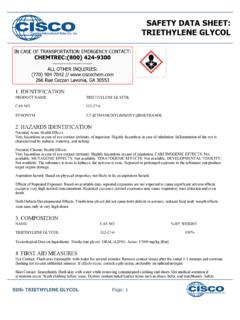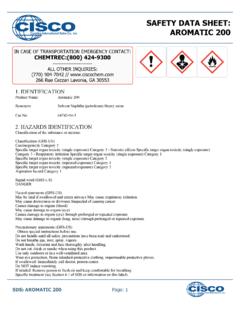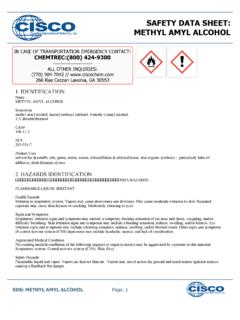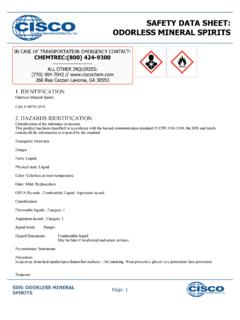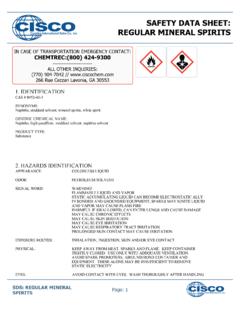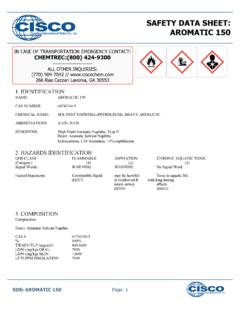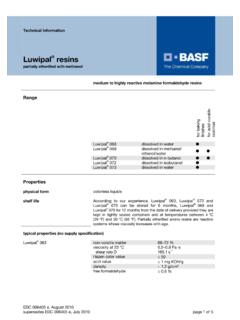Transcription of SAFETY DATA SHEET: DB ACETATE - ciscochem.com
1 SAFETY data sheet : DB ACETATE . IN CASE OF TRANSPORTATION EMERGENCY CONTACT: CHEMTREC:(800) 424-9300. ----------------------- ALL OTHER INQUIRIES: (770) 904-7042 // 266 Rue Cezzan Lavonia, GA 30553. 1. IDENTIFICATION. PRODUCT NAME: DB ACETATE . CAS NO: 124-17-4. CHEMICAL NAME: DIETHYLENE glycol MONOBUTYL ETHER ACETATE . 2. HAZARDS IDENTIFICATION. Hazard Classification: The product has not been classified as hazardous according to the legislation in force. OSHA Specified Hazards: not applicable Hazard(s) not otherwise Prolonged or repeated skin contact may cause drying, cracking, or irritation.
2 Classified (HNOC). 3. COMPOSITION. CHEMICAL NAME: CAS NO % BY WEIGHT. Diethylene glycol Monobutyl ACETATE 124-17-4 100%. 4. FIRST AID MEASURES. Description of first aid measures Inhalation: Treat symptomatically. Move to fresh air. Get medical attention if symptoms persist. Eye contact: Any material that contacts the eye should be washed out immediately with water. If easy to do, remove contact lenses. Get medical attention if symptoms persist. Skin contact: Wash with soap and water. Remove contaminated clothing and shoes.
3 Get medical attention if symptoms occur. Wash contaminated clothing before reuse. Destroy or thoroughly clean contaminated shoes. Ingestion: Seek medical advice. Material is not expected to be absorbed from the gastrointestinal tract so that induction of vomiting should not be necessary. Most important symptoms and effects, both acute and delayed: None known. Indication of any immediate medical attention and special treatment needed Hazards: SDS: DB ACETATE Page: 1. None known. Treatment: Treat symptomatically.
4 5. FIRE FIGHTING MEASURES. General Fire Hazards: None known. Extinguishing media Suitable extinguishing media: Water spray. Dry chemical. Carbon Dioxide. Foam. Unsuitable extinguishing media: None known. Special hazards arising from the substance or mixture: Forms peroxides of unknown stability. Advice for firefighters Special fire fighting procedures: None known. Special protective equipment for fire-fighters: Self-contained breathing apparatus and full protective clothing must be worn in case of fire. 6. ACCIDENTAL RELEASE MEASURES.
5 Personal precautions, protective equipment and emergency procedures: Wear appropriate personal protective equipment Environmental Precautions: Avoid release to the environment Methods and material for containment and cleaning up: Absorb spill with vermiculite or other inert material, then place in a container for chemical waste. Large Spillages: Flush spill area with water spray. Prevent runoff from entering drains, sewers, or streams. Dike for later disposal. Notification Procedures: In the event of a spill or accidental release, notify relevant authorities in accordance with all applicable regulations.
6 7. HANDLING AND STORAGE. Precautions for safe handling Avoid prolonged or repeated contact with skin. Wash thoroughly after handling. Minimize exposure to air. After opening, purge container with nitrogen before reclosing. Periodically test for peroxide formation on long- term storage. Do not allow to evaporate to near dryness. Do not distill to near dryness. Addition of water or appropriate reducing materials will lessen peroxide formation. Conditions for safe storage, including any incompatibilities: Keep container tightly closed.
7 Store away from heat and light. Specific End Use(s): Solvent 8. EXPOSURE CONTROLS AND PERSONAL PROECTION. Control Parameters SDS: DB ACETATE Page: 2. Occupational Exposure Limits Country specific exposure limits have not been established or are not applicable unless listed below. CHEMICAL NAME TYPE EXPOSURE LIMIT VALUES SOURCE. Diethylene glycol monobutyl ether ACETATE ST ESL 850 g/m3 US. Texas. Effects Screening Levels (Texas Commission on Environmental Quality) (03 2014). AN ESL 85 g/m3 US. Texas. Effects Screening Levels (Texas Commission on Environmental Quality) (03 2014).
8 Exposure controls Appropriate engineering controls: Good general ventilation (typically 10 air changes per hour) should be used. Ventilation rates should be matched to conditions. If applicable, use process enclosures, local exhaust ventilation, or other engineering controls to maintain airborne levels below recommended exposure limits. If exposure limits have not been established, maintain airborne levels to an acceptable level. Individual protection measures, such as personal protective equipment General information: Eye bath.
9 Washing facilities. SAFETY shower. Eye/face protection: It is a good industrial hygiene practice to minimize eye contact. Skin protection Hand Protection: It is a good industrial hygiene practice to minimize skin contact. For operations where prolonged or repeated skin contact may occur, chemical- resistant gloves should be worn. Contact health and SAFETY professional or manufacturer for specific information. Other: No data Available Respiratory Protection: If engineering controls do not maintain airborne concentrations below recommended exposure limits (where applicable) or to an acceptable level (in countries where exposure limits have not been established), an approved respirator must be worn.
10 In the United States of America, if respirators are used, a program should be instituted to assure compliance with OSHA Standard 63 FR 1152, January 8, 1998. Respirator type: Air- purifying respirator with an appropriate, government approved (where applicable), air- purifying filter, cartridge or canister. Contact health and SAFETY professional or manufacturer for specific information. Hygiene measures: Observe good industrial hygiene practices. Environmental Controls: No data available. 9. PHYSICAL AND CHEMICAL PROPERTIES.

